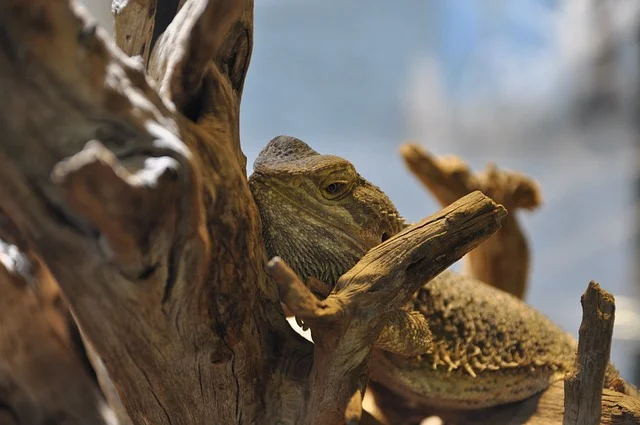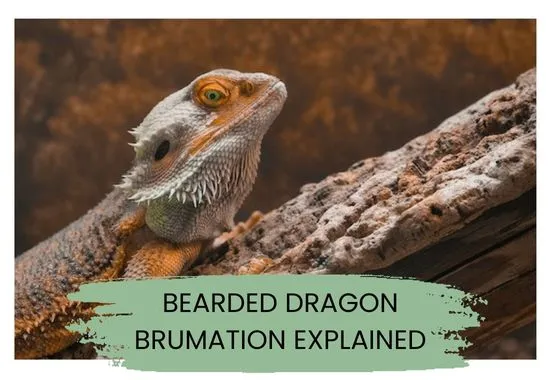Bearded dragon brumation, often likened to hibernation in mammals, is a crucial aspect of their life cycle. This period of dormancy, common in reptiles, is a natural response to seasonal changes, such as changes in temperature and daylight hours, mirroring the seasonal shifts in their native habitat. Understanding brumation is not only vital for ensuring the health and wellbeing of your pet but also enriches the experience of caring for these unique creatures.
In this comprehensive guide, we delve into the intricacies of brumation, equipping you with the knowledge to support your bearded dragon through this natural process.
If you want to learn more about how to properly care for your Breaded dragon, check out our Bearded dragon cre guide here.
What is Brumation?
Brumation is a reptile’s version of hibernation, characterised by a significant reduction in metabolic activity. During this time, bearded dragons enter a state of dormancy, which allows them to conserve energy when external conditions are less than ideal for regular activity, such as during colder months. Unlike hibernation, where animals are in a deep sleep, brumated reptiles experience a lethargic state, with occasional wakefulness for hydration and, in some cases, minimal food intake.
In their natural Australian habitats, bearded dragons use brumation to survive the cooler, less resource-abundant seasons. In captivity, even though they are provided with a consistent environment, bearded dragons still exhibit this instinctual behaviour. It’s a fascinating display of how deeply ingrained natural cycles remain, regardless of the controlled conditions in a domestic setting.

Recognising the Signs of Brumation in Bearded Dragons
Identifying the signs of bearded dragon brumation is crucial for providing them with appropriate care. Signs include:
- Decreased activity
- Reduced appetite
- More frequent hiding
As brumation approaches, you might observe your bearded dragon spending more time in its hide or basking less frequently. These behavioural changes are a dragon’s way of slowing down and preparing for a prolonged rest period. It’s important not to confuse these signs with illness, as they are natural responses to the changing environment. However, if you are unsure, consulting a veterinarian specialising in reptiles is always a wise step.
The Brumation Cycle: Frequency and Duration
The frequency and duration of brumation can vary significantly among bearded dragons. Factors influencing this include:
- Age
- Health
- Environmental conditions
- Individual temperament
While some may brumate annually, others might skip a year or brumate only every few years. The length of brumation also varies, typically lasting anywhere from a few weeks to several months. Younger dragons, for instance, may brumate for shorter periods or not at all. It’s essential to observe your pet’s unique patterns and adapt their care accordingly.
Preparing for Your Bearded Dragon Brumation
Preparing for brumation is key to ensuring your bearded dragon’s health during this period.
Prior to brumation, it’s advisable to reduce food intake, especially live prey, as a dragon’s digestive system slows down significantly. This precaution prevents undigested food from causing health issues. A visit to the vet for a pre-brumation check-up can help ascertain that your dragon is healthy enough to brumate and rule out any potential health concerns that might be mistaken for brumation behaviour.
Navigating through the bearded dragon brumation period can be challenging for owners. In the next section, we have compiled a detailed guide to help you through this process.

Caring for Your Bearded Dragon During Brumation: Detailed Care Instructions
Preparing the Vivarium for Brumation:
- Temperature Adjustment: Gradually lower the temperature in the habitat over a few weeks to mimic the natural cooling that occurs in the wild. Aim for a temperature range suitable for brumation, typically between 15-21°C (60-70°F).
- Lighting Changes: Reduce the hours of UVB light exposure to simulate shorter daylight hours. This helps in signaling your dragon that it’s time for brumation.
Monitoring Health and Safety:
- Weight Checks: Regularly weigh your bearded dragon to ensure they are not losing excessive weight during brumation.
- Hydration: Even though your dragon may eat less or not at all, ensure they have access to fresh water. Some dragons may wake up to drink before returning to their dormant state.
- Food intake: While some dragons may not eat at all, others may consume small amounts of food.
Handling Unexpected Issues During Brumation
- Sudden Changes in Behavior: If your bearded dragon shows signs of distress or sudden changes in behavior, consult a veterinarian. It’s crucial to differentiate between normal brumation behavior and potential health issues.
- Extended Brumation Period: If the brumation period extends beyond the typical timeframe (usually up to three months), seek advice from a reptile specialist. Extended brumation can sometimes indicate environmental or health problems.
Tips for First-Time Owners
- Observation is Key: Keep a close eye on your dragon’s behavior as they prepare for brumation. This helps in understanding their unique patterns and needs.
- Consult Experts: Don’t hesitate to consult with a veterinarian or experienced bearded dragon owners for advice, especially if you are unsure about your dragon’s behavior.
- Record Keeping: Maintain a log of your dragon’s brumation cycle, including when it starts and ends, any changes in behavior, and weight records. This information can be invaluable for future brumation cycles.
The Role of Environmental Factors in Brumation
Environmental factors play a critical role in brumation. While it’s necessary to mimic the cooler temperatures of winter, complete removal of heat and light sources is not advisable. Instead, reduce the temperatures to the lower end of the bearded dragon’s comfortable range, ensuring there’s still a gradient available. The UV lighting should also be reduced to reflect shorter daylight hours but not completely turned off. This approach helps maintain a natural rhythm and ensures that your bearded dragon can brumate safely and comfortably. For the ideal vivarium setup, check out our guide on Bearded Dragon Vivariums.
Addressing Common Concerns During Brumation
Many owners worry when their bearded dragon enters brumation, particularly if it’s their first experience. Common concerns include differentiating between brumation and illness, as symptoms can appear similar. Regular health checks are important to ensure that your dragon is simply brumating and not sick.
Prolonged or disrupted brumation cycles can also be a cause for concern. If brumation extends beyond the typical timeframe, or if your dragon frequently wakes up and returns to brumation, it might indicate that environmental conditions are not optimal or there are underlying health issues. In such cases, consulting a veterinarian is recommended.
The Awakening: Post-Brumation Care
When your bearded dragon begins to emerge from brumation, it’s a time to slowly reintroduce them to their regular routine. Here is what you need to remember:
- Don’t be alarmed: Initially, your bearded dragon may still show reduced activity and appetite.
- Gradual Transition: Once your dragon starts showing signs of waking up from brumation, gradually increase the vivarium temperature and lighting to their standard levels over several days. This gradual change helps your dragon adjust back to their regular metabolic rate
- Dietary Adjustment: Introduce food slowly. Start with easily digestible foods and gradually return to their regular diet as their appetite increases. Read our food recommendations for bearded dragons.
- Health Check-Up: After brumation, a vet check-up can ensure that your dragon has come out of brumation without any health issues.
Frequently Asked Questions About Bearded Dragon Brumation
- Can I force my bearded dragon to go into brumation?
Inducing brumation should only be considered if you plan to breed your bearded dragon. This involves reducing light hours and temperatures to mimic winter conditions, which can encourage brumation and increase fertility. - Is it possible to prevent my bearded dragon from brumating?
You cannot stop a bearded dragon from brumating once it starts. However, maintaining consistent lighting hours and temperatures might prevent the onset of brumation, especially in young or unhealthy dragons. - What is semi-brumation in bearded dragons?
Semi-brumation is a milder form of brumation where bearded dragons show reduced activity but do not completely cease eating or basking. In this state, they are less active than usual but still engage in some of their regular behaviors. - Should I be concerned if my bearded dragon loses weight during brumation?
A healthy bearded dragon should not lose significant weight during brumation. Some weight loss is normal due to reduced food intake, but their lower activity levels usually balance this out. - Can young bearded dragons under one year old enter brumation?
Yes, bearded dragons under one year old can enter brumation. The urge to brumate is instinctual and can occur at any age. However, younger dragons may not have the nutritional reserves to safely endure the brumation period, so a vet check-up is recommended to ensure their health and safety. - What should I do if my bearded dragon finishes brumation after only a few days?
If a bearded dragon appears to finish brumation after just a few days, it’s likely that they were not actually in brumation. This could be a sign of illness or parasites, so a vet check-up and fecal test are advised. Dragons may also have lazy days, which is normal, but true brumation typically lasts several weeks or more. - Is it harmful to delay or prevent a bearded dragon from entering brumation?
Delaying or preventing brumation when a bearded dragon is showing signs of wanting to brumate can cause issues. The dragon may try to conserve energy and nutrition by eating less and hiding, which can be stressful. It’s important to follow their lead and allow them to brumate if they are showing signs of wanting to do so. - What hormonal changes occur in bearded dragons during brumation?
Hormonal changes in bearded dragons during brumation can affect reproduction. Cooler temperatures can influence sperm production in males, while warmer conditions upon waking can aid female ovulation. Brumation serves not only as a survival mechanism but also as a crucial factor for optimal reproduction conditions
Conclusion: Ensuring a Healthy Brumation for Your Bearded Dragon
Understanding and supporting your bearded dragon through brumation is an integral part of their care. Recognising the signs, preparing adequately, and providing the right post-brumation care ensures that your dragon remains healthy throughout this natural process. Remember, each dragon is unique, and their brumation patterns can vary. Observing and learning from your pet will help you provide the best care during these periods of dormancy.
